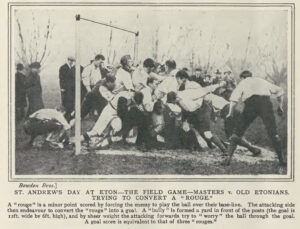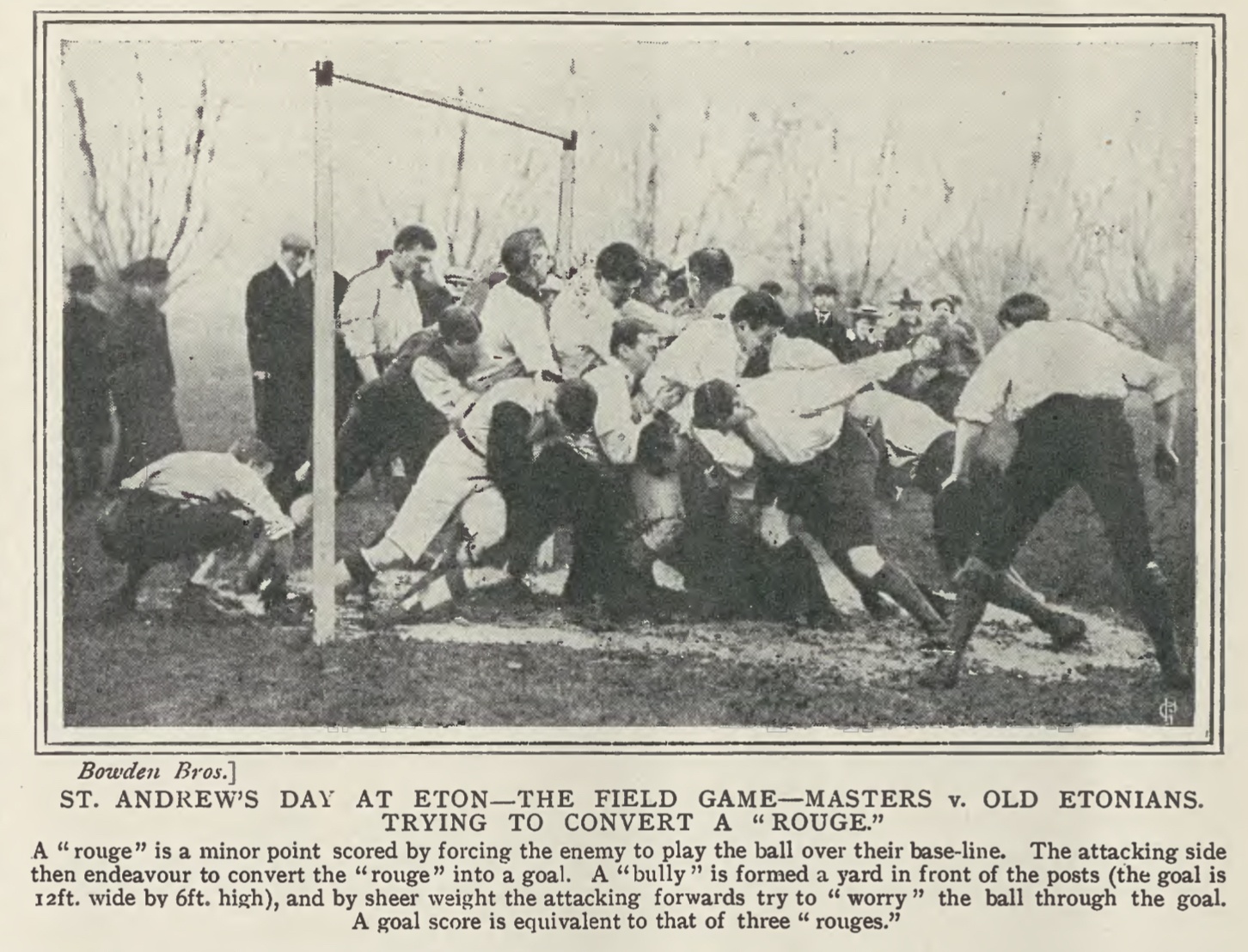Rouge. What is that supposed to be anyway? There is not one, but different styles of Rouges. In association football, which is widely played around the world, this style has not endured, but it has in rugby. Because a Rouge has certain similarities to a Try.
But what is a Rouge? Let me explain the styles in a clear and brief way.
The Rouge is, or was, part of the rules at Eton College (Eton Field Game) and Cheltenham College, as well as at Sheffield FC and in the Sheffield FA.

A Rouge in Eton Field Game. Source: Book of Football, S. 122.
Eton Field Game
Scoring
At Eton, a distinction is made as to by whom the ball goes out of bounds:
- by the defending team: A Rouge is scored directly if a player of the defending team touches it first.
- by the attacking team: The ball is then placed 1 yd from the goal post and the attacking team tries to push the ball over the goal line. As a bully is formed similar to a scrimmage, this is not so easy.
Awarding
In the mid-19th century, three Rouges outweighed a goal; by 1879 at the latest, the number of them was only interesting in games that ended in a draw, because a goal always counted more than any number of Rouges.
Like today with penalty kicks
Also important: A Rouge is also taken after the end of normal playing time, as is the case today with a penalty kick. The game was over when the ball was next out of bounds (i.e. another goal could be scored).
Restart of the game
If a Rouge was scored, play continued with a kick-off. For this, the ball was placed 1 yd centrally in front of the own goal and no player was allowed to touch the ball until the player who had received the Rouge had put the ball into play. The position of the other players is not mentioned.
Sheffield FC & Sheffield FA
Additional flags on the field
At Sheffield there were an additional four Rouge flags on the pitch, each 25 yd from the goalposts.
Scoring
As soon as the ball went unintentionally out of bounds between the goal and Rouge flags, the ball was rougeable.
Only the attacking team has the possibility to make the ball rougeable and only scores a Rouge if someone from their own team touches the ball first.
Restart of the game
If the defending team is first to the ball, then there is a kick-off from a choice of two places:
(1) the centre circle (players from the team that did not score the Rouge must stand no more than 6 ft from the goalposts,
(2) an unspecified other point (players from the team that did not score the Rouge must stand 2 yd and centred in front of the goalposts).
Cheltenham College
Very briefly, it should be mentioned that Rouge was also part of the rules in the rugby-type football game at Cheltenham College. They were probably scored similarly or in the same way as in Sheffield.
A Rouge scored a point (punt out = 2 points, try/touchdown = 3 points, goal = 9 points).
•
At this point, many thanks to Ged O’Brien for sharing and helping me research the different Rouge styles.
Ged O’Brien is Director of the SFA’s Scottish Football Museum at Hampden Park and an outstanding authority on Scottish football culture. His research convinces us that the early game of football in 19th century Scotland was already much more cultivated than in England and that the cradle of the game of football today is rather to be found in Scotland. I recommend his daily short threads on Twitter.


Pingback: Rules for determining the winner -
Pingback: Another variation of the penalty shootout -
Pingback: L'histoire des règles du football -
Pingback: La storia del regolamento del calcio -
Pingback: La historia de las reglas del fútbol -